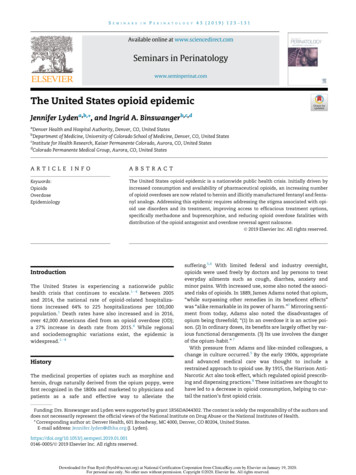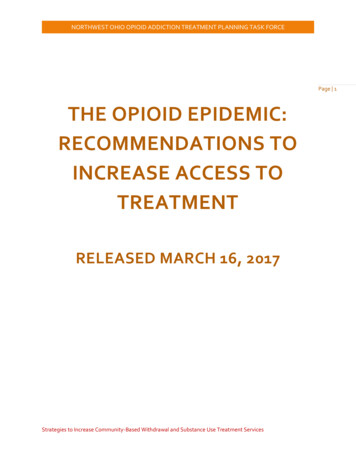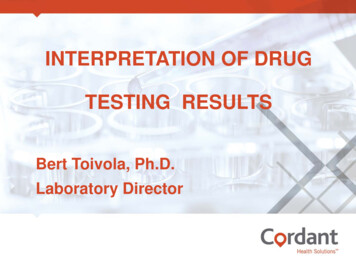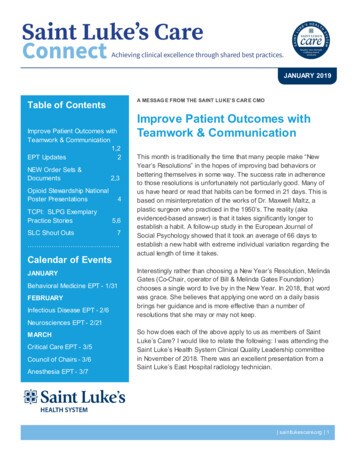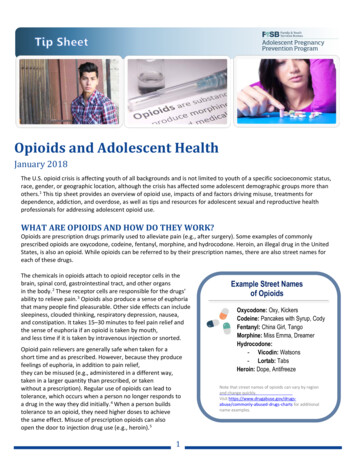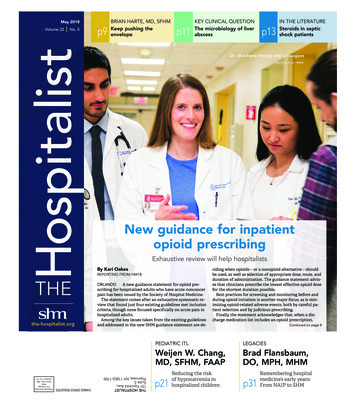
Transcription
May 2018Volume 22No. 5p9BRIAN HARTE, MD, SFHMKeep pushing theenvelopep11KEY CLINICAL QUESTIONThe microbiology of liverabscessp13IN THE LITERATURESteroids in septicshock patientsDr. Shoshana Herzig and colleaguesJAMES DEREK DWYER / BIDMCNew guidance for inpatientopioid prescribingExhaustive review will help hospitalistsBy Kari OakesREPORTING FROM HM18THE HOSPITALIST151 Fairchild Ave.,Suite 2,Plainview, NY 11803-1709the-hospitalist.orgORLANDO / A new guidance statement for opioid prescribing for hospitalized adults who have acute noncancerpain has been issued by the Society of Hospital Medicine.The statement comes after an exhaustive systematic review that found just four existing guidelines met inclusioncriteria, though none focused specifically on acute pain inhospitalized adults.Among the key issues taken from the existing guidelinesand addressed in the new SHM guidance statement are de-ciding when opioids – or a nonopioid alternative – shouldbe used, as well as selection of appropriate dose, route, andduration of administration. The guidance statement advises that clinicians prescribe the lowest effective opioid dosefor the shortest duration possible.Best practices for screening and monitoring before andduring opioid initiation is another major focus, as is minimizing opioid-related adverse events, both by careful patient selection and by judicious prescribing.Finally, the statement acknowledges that, when a discharge medication list includes an opioid prescription,Continued on page 8PEDIATRIC ITLLEGACIESWeijen W. Chang,MD, SFHM, FAAPBrad Flansbaum,DO, MPH, MHMp21Reducing the riskof hyponatremia inhospitalized childrenp31Remembering hospitalmedicine’s early years:From NAIP to SHMCHANGE SERVICE REQUESTEDPresorted StandardU.S. PostagePAIDPermit No. 384Lebanon Jct. KY
CAREER NEWSMay 2018Volumeolume 22HospitalistMovers and ShakersBy Matt PesynaJoshua D. Lenchus, DO, RPh, SFHM,has been named the president ofthe Florida Osteopathic MedicalAssociation,FOMA anouncedat a gala on Feb.24, 2018.Dr. Lenchus iscurrently a hospitalist at Jackson MemorialHospital, Miami,which is affilDr. Lenchusiated with theUniversity of Miami. He is the firsthospitalist to be named FOMApresident in at least 20 years,FOMA confirmed.Dr. Lenchus serves as the Societyof Hospital Medicine’s Public Policy Committee chair. He is notedfor his work as a clinician, hospitaladministrator, educator, and researcher.J. Kevin Shushtari, MD, FHM,recently was named chief medicalofficer at the New Britain (Conn.)Hospital for Special Care, where hewill focus on managing the medicalstaff, admissions,credentials, infection prevention,and clinical affiliations.Dr. Shushtari isthe founder of theMercy InpatientMedical Service,which was oneDr. Shushtariof the first fullystaffed hospitalist services in theUnited States.He comes to the Hospital forSpecial Care after spending nearly3 years as executive medical directorof post-acute services for the Sarasota (Fla.) Memorial Health CareSystem.Tianzhong Yang, MD, has beenselected as the new long-termcare medical director for Van DykHealthcare in Montclair, N.J. Dr.Yang began his career 3 decades agoin China and has been a hospitalistat Hackensack University MedicalCenter Mountainside, also in Montclair, since 2013.Dr. Yang has been an instructor atBrigham and Women’s Hospital inBoston, specializing in anesthesiology. At Van Dyk, he will work withthe nursing staff to help patientsPHYSICIAN EDITORDanielle B. Scheurer, MD, SFHM, MSCR;scheured@musc.edurecover their independence outsideof the hospital setting.Brent W. Burkey, MD, SFHM, alongtime hospitalist at the Cleveland Clinic, has been named thepresident of Fisher-Titus MedicalCenter in Norwalk, Ohio.Dr. Burkey has been the chiefmedical officer at the ClevelandClinic’s Avon, Ohio, location the past2 years. He helped the clinic openthe Avon hospital in 2016 whenhe served as vice president ofmedical affairs.Dr. Burkey has been a clinicalhospitalist since 2004, and he hasa master’s degree in business administration from Cleveland StateUniversity. He will run all hospitaland medical center operations atFisher-Titus, including quality andsafety.Christopher Maiona, MD, SFHM,a longtime veteran of hospitalmedicine, hasbeen named thechief medicalofficer for PatientKeeper, aphysician-centered softwarecompany basedin Waltham,Mass.Dr. MaionaDr. Maionawill guide the company’s productdevelopment, deployment, and optimization efforts.Dr. Maiona has extensive experience as a practicing hospitalphysician and as an executive.Most recently, he served as nationalmedical director for TeamHealth ofKnoxville, Tenn. He also has beenan instructor at Tufts Universityand Harvard Medical School, both inBoston.Tom Cummins, MD, has been appointed chief medical officer atBon Secours St. Francis HealthSystem in Greenville, S.C. Dr. Cummins comes to Bon Secours fromCatholic Health Initiatives St.Vincent, Arkansas, where he wassenior vice president and CMO; healso first served as a hospitalistwithin that system.At Bon Secours, Dr. Cumminswill oversee the regional healthsystem’s 11 facilities, includingSt. Francis Downtown in Judson,S.C., and St. Francis Eastside inGreenville.May 2018 6PEDIATRIC EDITORWeijen Chang, MD, FACP, SFHMWeijen.ChangMD@baystatehealth.orgCOORDINATING EDITORSChristine Donahue, MDTHE FUTURE HOSPITALISTJonathan Pell, MDKEY CLINICAL GUIDELINESCONTRIBUTING WRITERSMaryann T. Ally, MD, MPHWeijen W. Chang, MD, SFHMAli Farkhondehpour, MDBrad Flansbaum, DO, MPH, MHMBrian Harte, MD, SFHMBryan Huang, MD, FHMArkady Komsoukaniants, MDPooja Mehra, MDKari OakesAndrew Parsons, MD, MPHMatt PesynaSupraja Thota, MDKelly April TyrrellFRONTLINE MEDICALCOMMUNICATIONS EDITORIAL STAFFEditor in Chief Mary Jo M. DalesExecutive Editors Denise Fulton,Kathy ScarbeckEditor Richard PizziCreative Director Louise A. KoenigDirector, Production/ManufacturingRebecca SlebodnikEDITORIAL ADVISORY BOARDGeeta Arora, MD; Michael J. Beck, MD;Harry Cho, MD; Kevin Conrad, MD,MBA; Stella Fitzgibbons, MD, FACP,FHM; Benjamin Frizner, MD, FHM;Nicolas Houghton, DNP, RN, ACNP-BC;James Kim, MD; Melody Msiska, MD;Venkataraman Palabindala, MD, SFHM;Raj Sehgal, MD, FHM; Lonika Sood, MD,FACP, FHM; Sarah A. Stella, MD, FHM;Amanda T. Trask, FACHE, MBA, MHA,SFHM; Amit Vashist, MD, FACP, FHM;Miguel Angel Villagra, MD, FACP, FHM;Jill Waldman, MD, SFHMNo. 5THE SOCIETY OF HOSPITAL MEDICINEP: 800-843-3360 F: 267-702-2690Website: www.HospitalMedicine.orgLaurence Wellikson, MD, MHM, CEOVice President of Marketing & CommunicationsLisa Zokslzoks@hospitalmedicine.orgMarketing Communications ManagerBrett Radlerbradler@hospitalmedicine.orgMarketing Communications SpecialistFelicia Steelefsteele@hospitalmedicine.orgSHM BOARD OF DIRECTORSPresidentNasim Afsar, MD, SFHMPresident-ElectChristopher Frost, MD, SFHMTreasurerDanielle Scheurer, MD, MSCR, SFHMSecretaryTracy Cardin, ACNP-BC, SFHMImmediate Past PresidentRon Greeno, MD, FCCP, MHMSteven B. Deitelzweig, MD, MMM, FACC,FACP, SFHMHoward R. Epstein, MD, SFHMKris Rehm, MD, SFHMBradley Sharpe, MD, FACP, SFHMJerome C. Siy, MD, SFHMRachel Thompson, MD, MPH, SFHMPatrick Torcson, MD, MMM, SFHMFRONTLINE MEDICALCOMMUNICATIONS ADVERTISING STAFFVP/Group Publisher; Director,FMC Society PartnersMark BrancaDirector, Business DevelopmentAngela Labrozzi, 973-206-2971cell 917-455-6071, alabrozzi@mdedge.comClassified Sales RepresentativeHeather Gonroski, 973-290-8259hgonroski@mdedge.comLinda Wilson, 973-290-8243lwilson@mdedge.comSenior Director of Classified SalesTim LaPella, 484-921-5001cell 610-506-3474, tlapella@mdedge.comAdvertising Offices 7 Century Drive,Suite 302, Parsippany, NJ 07054-4609973-206-3434, fax 973-206-9378To learn more about SHM’s relationship with industry partners, visit www.hospitalmedicine.com/industry.The Hospitalist
SOCIETY NEWSTower Health teams with SHM as first healthsystem institutional partnerPennsylvania health system to offer customized SHM benefitsReading (Pa.) Health Systemhas had a long-standing relationship with the Societyof Hospital Medicine. WalterR. Bohnenblust Jr., MD, SFHM, theformer medical director of hospitalist services at Reading Hospitalin West Reading, had been an SHMmember since 2002. He worked together with his dyad partner, whowas trained in the SHM LeadershipAcademy curriculum, for 20 years.Together at Reading Hospital, theyparticipated in several SHM Centerfor Quality Improvement MentoredImplementation programs on topicsthat included opioid management,care transitions, glycemic control,and VTE treatment.Today, Reading Health System isknown as Tower Health, which recently acquired five hospitals in thesoutheastern Pennsylvania region.John K. Derderian, DO, FHM, director of hospitalist services, is leadingthe growth of the hospitalist programs and made the strategic decision to become an SHM institutionalpartner by enrolling his entire staff– which consists of 70 physiciansand 20 nurse practitioners and physician assistants who provide acutecare in a 711-bed hospital – as SHMmembers.“I am proud to say the hospitalistgroup at Reading Hospital is committed to continuous improvementand the providers recognize that thepartnership will be an effective toolto achieve their goals,” Dr. Derderiansaid. “The team at Tower Health isexcited about the opportunity to partner with SHM and the potential forour providers to have a single sourcefor all of their career needs – continuing medical education and profession-al development, to name a few.”Reading Hospital also has enrolledin SHM’s Optimizing NeurovascularIntervention Care for Stroke PatientsMentored Implementation program,which provides resources and training to equip practitioners with theskills needed to ensure continuousquality of care for stroke patients.Defining the value of the hospitalmedicine program for Tower Health’sleadership is a topic that is importantto Dr. Derderian also. “SHM’s Stateof Hospital Medicine [SoHM] Reportprovides exquisite detail of programsaround the country, giving TowerHealth’s providers invaluable insightinto the changes of the hospital medicine landscape occurring across thecountry and the value of the hospitalist team,” he said.Eric Howell, MD, MHM, who servesas senior physician adviser to SHM,traveled to Reading Hospital to sharehis experience as chief of the divisionof hospital medicine at Johns Hopkins Bayview Medical Center, Baltimore. Dr. Howell shared his metricsdashboard with the Reading hospitalmedicine staff to provide insight intohow to measure the effectiveness ofthe hospitalist team.“This was an excellent exampleof how these institutional partnerships create important dialoguebetween SHM and our partnermembers, resulting in customizedbenefits,” said Kristin Scott, directorof business development at SHM.For more information about SHM’sinstitutional partnerships, pleasecontact Debra Beach, SHM CustomerExperience Manager, at 267-7022644 or dbeach@hospitalmedicine.org.SHM and Neurohospitalist Society partner onnew program for stroke patientshe Society of Hospital Medicine recentlypartnered with the Neurohospitalist Society (NHS) to apply the neurology, stroke,and neurohospitalist expertise of NHS to thehospital and mentored implementation expertise of SHM for a uniquely positioned programfor hospitals and health care systems: the Optimizing Neurovascular Intervention Care forStroke Patients Mentored Implementation program.This program aims to provide the resourcesand training to equip neurologists and hospitalswith the skills to help ensure continuous qualityin the care of stroke patients with large vessel occlusions. The program will help clinicians identifyopportunities to engage multidisciplinary teammembers to implement evidence-based management practices in their hospital.Reading Hospital–Tower Health, West Reading,Pa., was one of four hospitals selected to participate in the first wave of this program. TowerHealth also recently became SHM’s first healthsystem institutional partner.The Hospitalist spoke with Reading Hospitalstaff about the program.TWhat led you to partner with SHM for thisprogram?Deepam Gokal, MD, is an associate director ofhospitalist services and co–medical director ofthe stroke program, a member of SHM, and aformer member of NHS; he received an emailregarding the Mentored Implementation program for continuous quality monitoring andimprovement in the care of stroke patientswith large vessel occlusions. Karen Hoerst, MD,is a vascular neurologist and stroke programco–medical director, and Ruth Bailey, RN, is thestroke program manager. Together, we reviewedthe introductory webinar with Dr. Gokal andfelt this program would be beneficial for ourorganization, in particular because of ReadingHospital’s recent acquisition of five hospitals toform Tower Health and to help fulfill our visionto become the hub facility and a comprehensivestroke center.Did you have a history with SHM prior tothis program and partnership?Reading Hospital participated in Project BOOST,SHM’s care transitions Mentored Implementation program, from 2012 to 2013. The goal was tooptimize the hospital discharge process and tomitigate and prevent known complications anderrors that occur during transitions. This waschampioned by hospitalists Walter R. Bohnenblust Jr., MD, SFHM, former director of hospitalist services, and Binu Pappachen, MD, FHM.The pain management provider team at Reading Hospital also championed an opioid management Mentored Implementation program in2016-2017.the-hospitalist.org 7May 2018How might this program affect outcomes?The aim is to provide better care for individuals, improve health strategies, and reducehealth care costs. This mentorship programshould support this commitment to valuebased care and population health management. It should prove beneficial to ReadingHospital by optimizing neurovascular interventions, which will help it become the intended hub for the Tower Health TeleneurologyProgram.What will success look like?Future success for hospitalist services at ReadingHospital will include the fruition of a neurohospitalist subspecialty. Participation in this mentoredimplementation program should provide valuableresources for the development of this subspecialty that align with the vision of Reading Hospital’sAdvanced Primary Stroke Center. This vision isto serve as the comprehensive stroke center ofchoice for the patients both in our communityand the surrounding region and to provide themwith 24/7 state-of-the-art complex stroke treatment with demonstrated optimization of qualitypatient outcomes throughout the continuum ofcare.For more information about SHM’s MentoredImplementation programs, visit hospitalmedicine.org/qi.
SDOMINICK / I S TOCK /G ETTY I MAGESthere is potential risk for misuse ordiversion. Accordingly, the recommendation is to limit the duration ofoutpatient prescribing to 7 days ofmedication, with consideration of a3-5 day prescription.An interactive session at the 2018SHM annual conference presentingthe guidance statement focused lesson marching through the 16 specificstatements in the guidance, andmore on teasing out the why, when,how – and how long – of inpatientopioid prescribing.The well-attended session, ledby two of the guideline authors,Shoshana Herzig, MD, MPH, andTeryl K. Nuckols, MD, FHM, beganwith Dr. Herzig, director of hospitalmedicine research at Beth IsraelDeaconess Medical Center, Boston,making a compelling case for whyguidance is needed for inpatient opioid prescribing for acute pain.“Few would disagree that, at theend of the day, we are the final common pathway” for hospitalized patients who receive opioids, said Dr.Herzig. And there’s ample evidencethat troublesome opioid prescribingis widespread, she said, adding thatassociated problems aren’t limitedto such inpatient adverse eventsas falls, respiratory arrest, andacute kidney injury; plenty of opioid-exposed patients who leave thehospital continue to use opioids inproblematic ways after discharge.Of patients who were opioid naiveand filled outpatient opioid prescriptions on discharge, “Almost halfof patients were still using opioids90 days later,” Dr. Herzig said. “Hospitals contribute to opioid initiationin millions of patients each year, soour prescribing patterns in the hospital do matter.”“We tend to prescribe high doses,”said Dr. Herzig – an average of a 68-mgoral morphine equivalent (OME) doseon days that opioids were received,according to a 2014 study she coauthored. Overall, Dr. Herzig and hercolleagues found that about 40% ofpatients who received opioids had adaily dose of at least 50 mg OME, andabout a quarter received a daily doseat or exceeding 100 mg OME (Herziget al. J Hosp Med. 2014 Feb;9[2]:73-81).Further, she said, “We tend to prescribe a bit haphazardly.” The samestudy found wide variation in re-gional inpatient opioid-prescribingpractices, with inpatients in the U.S.Midwest, South, and West seeingadjusted relative rates of exposureto opioids of 1.26, 1.33, and 1.37, compared with the Northeast, she said.Among the more concerning findings, she said, was that “hospitalsthat prescribe opioids more frequently appear to do so less safely.”In hospitals that fell into the topquartile for inpatient opioid exposure, the overall rate of opioidrelated adverse events was 0.39%,compared with 0.21% for hospitalsin the bottom quartile of opioidprescribing, for an overall adjustedrelative risk of 1.23 in opioid-exposedpatients in the hospitals with thehighest prescribing, said Dr. Herzig.Dr. Nuckols, director of the division of general internal medicineat Cedars-Sinai Medical Center, LosAngeles, engaged attendees to identify challenges in acute pain management among hospitalized adults.The audience was quick and prolific with answers, which includedvarying physician standards for opioid prescribing; patient expectationsfor pain management – and sometimes denial that opioid use hasbecome a disorder; varying expectations for pain management amongcare team members who may be reluctant to let go of pain as “the fifthvital sign;” difficulty accessing andbeing reimbursed for nonpharmacologic strategies; and, acknowledgedby all, patient satisfaction scores.To this last point, Dr. Nuckols saidthat there have been “a few recentchanges for the better.” The JointCommission is revising its standardsto move away from pain as a vitalsign, toward a focused assessmentof pain that considers how patientsare responding to pain, as well asfunctional status. However, she said,“There aren’t any validated measures yet for how we’re going to dothis.”Similar shifts are underwaywith pain-related HCAHPS (theHospital Consumer Assessment ofHealthcare Providers and Systems)questions, which have undergone a“big pullback” from an emphasis oncomplete control of pain, and nowput more focus on whether caregivers asked about pain and talkedwith inpatients about ways to treatMay 2018 8Continued from page 1pain, said Dr. Nuckols.Speaking about the process ofdeveloping the guidance statement,Dr. Nuckols said that “I think it’simportant to note that the empiricalliterature about managing pain forinpatients is almost nonexistent.”Of the four criteria that met inclusion criteria – “and we were toughraters when it comes to the guidelines” – most were based on expertconsensus, she said, and most hadan outpatient focus primarily.Themes that emerged from thereview process included consideration of a nonopioid strategy beforeinitiating an opioid. These mightinclude pharmacologic interventions such as acetaminophen or anNSAID for nociceptive pain, pregabalin, gabapentin, or other medication to manage neuropathic pain,or nonpharmacologic interventionssuch as heat, ice, or distraction. Allof these also should be consideredas adjuncts to minimize opioid dosing as well, said Dr. Nuckols, citingwell-documented synergy with multiple modalities of pain treatment.Careful patient selection is alsokey, said Dr. Nuckols. She noted thatshe asks herself, “How likely is thispatient to get into trouble?” withinpatient opioid administration. Aconcept that goes hand in hand, shesaid, is choosing the appropriatedose and route.Dr. Herzig picked up this theme,noting that route of administrationmatters. A speedy route, such as intravenous administration, has beenshown to reinforce the potentiallyaddictive effect of opioids. There aretimes when IV is the route to use,such as when the patient can’t takemedication by mouth or when immediate pain control truly is needed.However, oral medication is just aseffective, albeit slightly slower acting, she said.Conversion from IV to oral opioids is a potential time for trouble,said Dr. Herzig. “Always use anopioid conversion chart,” she said.Cross-tolerance can be incompletebetween opioids, so safe practice isto begin with about 50% of the OMEdose with the new medication andtitrate up. And don’t use a longacting opioid for acute pain, shesaid, noting that not only will therebe a long half-life and washout peri-The HospitalistLOU FERRARO, PARK SOUTH PHOTOGRAPHYInpatient opioid prescribingDr. Teryl Nuckols said hospitalistsare the “final common pathway” forhospitalized patients who receiveopioids.od if the dose is too high, but patientrisk for later opioid use disorder isalso upped with this strategy. “Youcan always add more, but it’s hard totake away,” said Dr. Herzig.On discharge, consider whetheran opioid should be prescribed at all,said Dr. Herzig. The guidance statement advises generally prescribingless than a 7-day supply, with therationale that, if posthospitalization acute pain is severe enough torequire an opioid at that point, thepatient should have outpatient follow-up.This approach doesn’t undertreatoutpatient pain, said Dr. Herzig,pointing to studies that show that,at discharge, “the majority of opioidsthat patients are getting, they arenot taking – which tells us that bydefinition we are overprescribing.”The authors of the guidancestatement wanted to address twoimportant topics that were not sufficiently evidence backed, Dr. Herzigsaid. They had hoped to give clearguidance about best practices forcommunication and follow-up withoutpatient providers after hospitaldischarge. Though they didn’t findclear guidance in this area, “We dobelieve that outpatient providersneed to be kept in the loop.”A second area, currently a hotbutton topic both in the medicalcommunity and in the lay press, iswhether a naloxone prescriptionshould accompany an opioid prescription at discharge. “There just aren’t studies for this,” said Dr. Herzig.The full text of the guidance statement may be found here: -opioid-use-acute-noncancer-pain.
COMMENTARYKeep pushing the envelopeBy Brian Harte, MD, SFHMBy the time this column ispublished, we will havewrapped up HM18 in Orlando, and I will have completedmy year as past president, as well asmy 6-year tenure on the Society ofHospital Medicine board of directors.I can imagine that will feel like arelief and a milestone, and it alsowill feel like a loss to no longer bepart of something that I have contributed my time, energy, passion,and emotion to for so long. I willretire at the ripe age of 48 years – apretty typical age for ending SHMboard tenure, and it’s terribly important for SHM that I do so.One of the great attributes ofthe society is that, despite turning20 last year, it feels young. And byyoung, I don’t just mean that theage of most board members is wellunder 50 years (although it is) orthat the staff of the society is largely millennials (although they are). Imean that we do not feel beholdento or burdened by tradition or whata “typical” professional society does.If you attended HM18, I hope youappreciated, as I do every year, theenergy, enthusiasm, and youth – ifnot in years, then in spirit – of theevent and of hospitalists. As a societyand a profession, we take risks. Wehave set standards for excellence inhospital medicine programs. We haverecognized a unique set of competencies and then not only attemptedto expand them with education butalso defined a specialty around them.We have welcomed practitioners andadministrators as equals into ourfold. These and many other accomplishments are the work of a board,committees, chapter leaders, andmembers who look for opportunitiesto expand our work into new andnecessary domains and are not limited by precedent.On the SHM board and committees, we tackle issues of governanceand strategy. For most of us, theSHM board is our first exposure tononprofit oversight. And, to be sure,there is a steep learning curve as newmembers discover the issues andsubstance of the work of the society.I recall that I barely spoke the firstyear on the board, uncertain whetherI understood items fully, and I alsowas burned once or twice by makingsuggestions that reflected my lack ofknowledge. While ignorance slowlygave way to experience, we also matured as a groupas we found waysto debate and resolve tough, sometimes ambiguous,issues.I came to appreciate that thestrength of theboard – and ofDr. HarteSHM – is thatwe join the board naive to much ofthe past. After 6 years, while I mayhave come to understand issues withgreater depth, I also see that thenewer members bring fresher thinking, creative energy, and thoughtsabout how the group could functionbetter. Over the last few years, I realized that we veterans had developeda cadence and predictability to ourwork and every year’s new membersdisrupt that rhythm. This disruptionforces us to challenge each other andto be a better board and to representand advocate for our membershipbetter.So it’s time for me to move on.Even though I certainly feel like Istill could contribute, it’s time toretire my own way of thinking fromthe leadership of SHM. The fact thatwe term-limit out at a relativelyyoung age is, I believe, an extraordinary aspect of our organization.SHM is an organization that, fromthe top down, embraces change inways that few others do. I believewe owe it to you to keep pushingthe envelope of creativity. I ask allof you to continue challenging theSHM leadership to be disruptive, topush the profession to better places, and to always strive to be morediverse, inclusive, communicative,visible – and to stay young. In spiritand attitude if not in age. Thank youfor giving me the opportunity towork on your behalf. It has been thegreatest privilege of my career.Dr. Harte is a past president of SHMand president of Cleveland ClinicAkron General and Southern Region.SHM’s SpecialInterest Groups Join a targeted network, exclusively forSHM members. Collaborate, seek advice and exchange ideas. Help shape the goals and direction of SHM.Join the conversation onlinehospitalmedicine.org/sigsthe-hospitalist.org 9May 2018
ANALYSISPhysician learning must evolve asindustry transformsTraining addresses communication challengesBy Eric Barna, MDIn medical school, students aretrained on skills that will makethem better future physicians,team members, and care givers. It’sa curious thing: Once we make headway into our medical careers andour days are filled with patient visitsand paperwork, we rarely have theopportunity to assess our skill sets inthe same way, despite the fact thatnew technologies and approaches totreatment have emerged since manyof us attended medical school.As a hospitalist at Mount SinaiHospital in New York, I’m part of ateam that cares for moderately to severely ill patients at a major academic institution. I’m also a physicianadvisor, and I have the pleasure ofteaching some of the brightest medical students, interns, and residents atvarious stages of their careers. I consider this the best part of my work,so I’m sure it comes as no surprisethat I’m a firm believer in the importance of continuous learning.That’s why I was so excited whenI had the chance to participate inthree standardized patient encounters training scenarios designed forme and my 22 hospitalist colleaguesto improve our communicationskills; this training was funded bya grant from the Doctors CompanyFoundation. A standardized patientencounter is essentially a live simulation in a clinical setting withtrained actors.To start the simulation, a physician is given a short prompt aboutthe patient scenario. They may alsobe provided with some basic information, such as a diagnosis or a relevant imaging study, prior to enteringthe room. Once the testing centerprovides a signal, physicians areallowed to enter the room. An introduction of our role on the medicalteam is provided, and a discussionensues. The actors provide relevantTRANSFORM / EXCEL / INSPIRERegister today.shmleadershipacademy.orgMay 2018 10history, incorporate true emotionalresponse to questioning, and displayany behavioral or physical promptsthat a real patient would. This allows physicians toreact in real timeto the needs ofthe patient. Theuse of standardized patients canalso be adaptedto desired testingscenarios, whichmight deal withDr. Barnaissues like communication, clinical reasoning, orestablishing a differential diagnosis.Like many hospitals, we have aprogram in place aimed at assessing how we educate students andyounger physicians. But MountSinai is the first hospital in NewYork that has established a programdesigned specifically to assess andaddress some of the unique communication challenges we face as hospitalists to improve patient care.As hospitalists, we’ve never metpatients or families before beginning conversations at critical pointsof care. It takes sensitivity and aparticular thoughtfulness to createrapport and share substantial information with a patient even withouthaving a prior relationship.During the training, my colleaguesand I each encountered three different standardized patients in keyscenarios: one at daily rounds, oneupset over a missed diagnosis, andone at discharge, when the potentialfor errors and miscommunication isgreatest. We were videotaped duringthe encounters for our personalreview, and we received direct feedback afterw
Bon Secours St. Francis Health System in Greenville, S.C. Dr. Cum-mins comes to Bon Secours from Catholic Health Initiatives St. Vincent, Arkansas, where he was senior vice president and CMO; he also first served as a hospitalist within that system. At Bon Secours, Dr. Cummins will oversee the regional health system s 11 facilities, including
